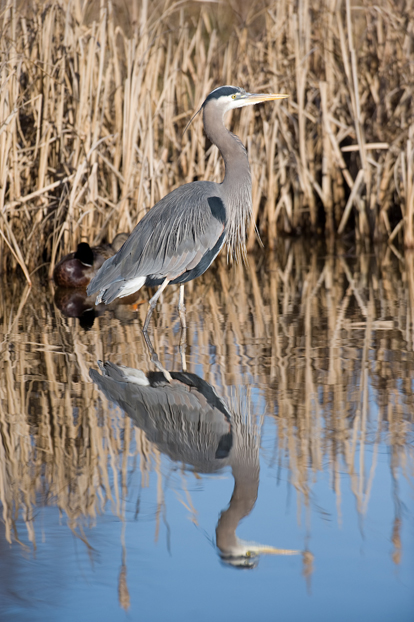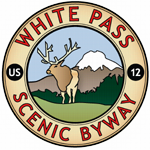Listen and you’ll hear them… cackling, squawking, honking or chattering. And then you’ll see them, from a marsh wren perched high up on a tree branch to a wood duck floating on an open pond. Taking time to view birds in their natural habitats can be an inspiring experience, deepening our appreciation of nature and renewing our wonder for the great outdoors. Superb locations for birding exist all along The White Pass Scenic Byway, an area well recognized for its abundant bird populations.
Here are a few top picks for birding along the Byway:
- Lewis and Clark State Park
- Swofford Pond
- Peterman Ridge Unit of the Cowlitz Wildlife Area
- Kosmos Unit of the Cowlitz Wildlife Area
- Kiona Creek Unit of the Cowlitz Wildlife Area
- Woods Creek Wildlife Area
- Packwood Lake
- Mt. Rainier National Park
- Oak Creek Wildlife Area
- Cowlitz Falls Day Use Park
- Davis Lake Unit of the Cowlitz Wildlife Area

Birding Hotspots
Lewis and Clark State Park
Here’s the place for a beginning birder. 621-acre Lewis and Clark State Park attracts birds with streams, wetlands and old-growth forests of Douglas firs. Watch for California Quail, Hairy and Pileated Woodpeckers, Steller’s Jays, Common Ravens, and Great Horned Owls. Take the self-guided half mile Old-Growth Interpretive Trail taking off from the first parking area. Seven additional miles of trails criss-cross the park.
Find more information on birding at Lewis and Clark State Park.
Swofford Pond
Many birds of many species can be spotted at Swofford Pond. Located near Mossyrock, this 220-acre pond is surrounded by wetlands and mature deciduous trees. Birding is excellent year-round. Take a quiet walk along a 1.25 mile shoreline trail, or watch from the water in a non-motorized boat.
Birds commonly seen include Western grebes, and nesting ospreys, plus common loons, Barrow’s goldeneyes, and common mergansers. Listen for Ruby-crowned kinglets and pine siskins singing high in the cottonwoods. See Pacific-slope and willow flycatchers in the alders. Red crossbills can be seen late spring to late autumn. Winter brings northern shrikes, northern shovelers, lesser scaups and northern pintails. Also staying the winter includes blue-winged, green-winged, and possible cinnamon teal as well as an occasional ring-necked duck. Living year-round in this birding paradise includes American kestrels, bald eagles, red-breasted sapsuckers, and downy, hairy and pileated woodpeckers.
Find more information on birding at Swofford Pond.
Peterman Ridge Unit of the Cowlitz Wildlife Area
As the largest unit on the Cowlitz Wildlife Area, with 6,840 acres south of Morton, Peterman Ridge is managed primarily for the pileated woodpecker, black-tailed deer, and Douglas squirrels. Ten miles of multi-use trails makes this area an easily accessed birding area. The single track trails connect forest roads across the land.
For more information on birding at the Peterman Ridge Unit.
Kosmos Unit of the Cowlitz Wildlife Area
Ponds, three perennial creeks, emergent wetlands, riparian forest and riparian shrub habitats make up the 750 acres of the Kosmos Unit of the Cowlitz Wildlife Area on the east end of Riffe Lake. It is well known as a top spot to brush up on spring sparrow identification. Watch for Chipping, Savannah, Lincoln’s, White-crowned, and Golden-crowned. Spot Wood Ducks in the wetland areas. Birds of prey, eagles, shorebirds and songbirds, upland birds and waterfowl all make their home here. In the summer months watch for ospreys; in autumn spot bald eagles and Cooper’s Hawks.
Find more information on birding at the Kosmos Unit.
Kiona Creek Unit of the Cowlitz Wildlife Area
The Kiona Creek area offers a nice stroll along the creek through deciduous and coniferous forests and offers a peaceful and quiet area for bird watching. Birds of prey, eagles, songbirds and waterfowl all make their home in these lands. Those birders looking to practice spring sparrow identification need look no further. Chipping, Savannah, Lincoln’s, White-crowned and Golden-crowned sparrows can all be spotted. Three creeks flow through the area, Squaw, Kiona and Oliver Creeks. Watch the wetland areas for Wood Ducks and the trees for Black-headed and Evening Grosbeaks.
Find more information on birding at the Cowlitz Wildlife Area.
Woods Creek Wildlife Area
Looping through five habitat areas, this area inside the Gifford Pinchot National Forest offers birders an excellent opportunity to view birds in several different habitats, all along the same trail. Begin this forest walk in a mixed hardwood conifer forest, then break into the bright openness of a meadow, leading to a beaver pond before entering a hardwood forest. This figure eight trail is built to barrier free standards by volunteers. It is 4 feet wide with compacted gravel surfacing; making it a nice nature trail for birders of all ages. The Woods Creek Watchable Wildlife Trail No. 247 is 1.5 miles long. At the halfway point, 1-mile Old-Growth Loop Trail No. 247A begins.
Birds common to Woods Creek include warbling vireos and red-breasted sapsuckers in the deciduous riparian trees and shrubs, April through October. Scan the area for Wilson’s, MacGillivray’s and black-throated gray warblers; and Pacific-slope, willow and Hammond’s flycatchers. In the wetland areas, see wood ducks on pond. Virginia rails, common yellowthroats and marsh wrens can be spotted in the cattails. Best viewing seasons include spring and summer. Morning and evening are prime viewing times.
To get to Woods Creek from Highway 12, turn south onto Highway 131 at Milepost 115 in the town of Randle. Drive 0.9 miles. Bear right at the “Y” onto Forest Service Road 25. Drive 4.6 miles. Turn left into Woods Creek Wildlife Area.
Find more information on birding at Woods Creek Wildlife Area.
Packwood Lake
Located in the Cascade Mountains near the mountain community of Packwood, its namesake lake is roughly two miles long and .6 miles wide and is considered a birding hotspot in the area. Birds common to the Packwood Lake area include Winter Wrens, Brown Creepers, Red-breasted Nuthatches, Chestnut-backed Chickadees, Townsend’s Warblers, Varied and Swainson’s Thrushes and Hammond’s Flycatchers. At the lake, keep on the watch for Common Loons, and Common and Barrow’s Goldeneyes. Listen for Hairy and Pileated Woodpeckers tapping on the trees, and view loons and Ospreys fishing the lake. Bald eagles are often seen cruising the sky and wood ducks float near the lake’s edge.
To access the Packwood Lake trailhead from Packwood, follow U.S. Highway 12 to the east end of town and turn south-east onto Forest Road 1262, next to the former USFS Packwood Ranger Station. Continue southeast on FR 1262 for 6 miles to the trailhead parking lot. The Packwood Lake trail is a nine mile round trip hike.
Mount Rainier National Park
Mt. Rainier National Park is well-known as a birder’s paradise with 165 species of birds living within the park’s borders. Some of these birds are year-round residents while others make the park their home during certain seasons of the year. Among the most commonly viewed birds are Thrushes, Chickadees, Kinglets, Clark’s Nutcracker, Ptarmigan, Grouse, Steller’s and Gray Jays, Eagles, Grosbeaks and Finches.
The distribution of birds in the park can be broken into the life zones of the park, and is related to elevation. Near Ohanapecosh, below 3500 feet elevation, walk the Grove of the Patriarchs and Eastside Trail. Making their home in this area, are Gray and Steller’s Jays, Varied Thrush, Olive-sided Flycatcher, Chestnut-backed Chickadee, Townsend’s Solitaire, Western Tanager, Townsend’s Warblers, and Pine Siskin. Watch for American Dippers along the river. Also at a lower elevation, at Longmire, take the Trail of the Shadows watching for Band-tailed Pigeon and Red-breasted Sapsucker, as well as Vaux’s Swift, Clark’s Nutcracker, Red-winged Blackbird, Brown Creeper, Canadian Geese, Golden-crowned Kinglets, Varied Thrush and Mountain Bluebird.
Between 5000 and 6500 feet elevation of the park many birds make their home, especially in the summer. At Sunrise, short nature trails provide opportunities to view White-tailed Ptarmigan, Clark’s Nutcrackers, Gray Jays and Gray-crowned Rosy-Finches. Less common are Blue Grouse, Evening Grosbeaks, and Cooper’s Hawks. See Common Ravens nesting on cliffs near Burroughs Mountain and watch for Golden Eagles from high lookouts such as Emmons Vista and Mount Fremont Lookout. In August watch for soaring raptors, including Osprey. In the Paradise meadows, Rufous Hummingbirds are often seen buzzing about.
Find a checklist of birds inhabiting Mt. Rainier National Park.
Oak Creek Wildlife Area
Wildlife is plentiful within the 40,366 acre Oak Creek Wildlife Area. Well-known for its winter elk-feeding program, it is also an area with large bird populations. Specialty birds to watch include, Northern Goshawk; Flammulated and Northern Pygmy-Owls; Vaux’s Swift; Black-chinned, Calliope, Rufous Hummingbirds; White-headed, Lewis’s, and Pileated Woodpeckers; Williamson’s and Red-naped Sapsuckers; Hammond’s and Pacific-slope Flycatchers and the Western Bluebird. During the winter feeding season, bald and golden eagles are plentiful at the wildlife area headquarters. Birds can be viewed year-round, but the high seasons include spring, summer and fall.
This area provides several different habitats for bird watching. The creek canyon is certainly the highlight for bird watching, but take time to scan other areas as well. Watch cliff faces for raptors. Check the river for Harlequin Ducks. The oak trees in the region are home to Lewis’s Woodpeckers. At the horse camp, look for Western Tanager, sparrows, and Western Wood-Pewee.
Find more information on birding at Oak Creek Wildlife Area.
Additional information on Bird Watching along the Byway
Audubon Washington: The Great Washington State Birding Trail
The Cowlitz Wildlife Area
Washington Birder – Lewis County
Washington Birder – Yakima County
